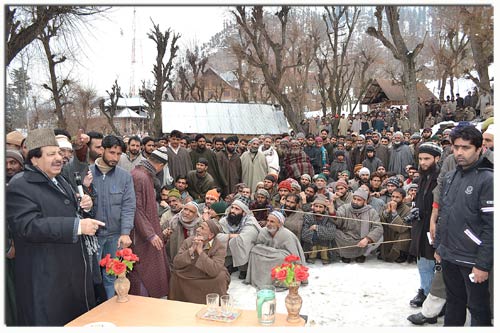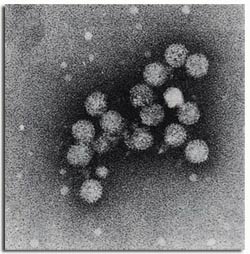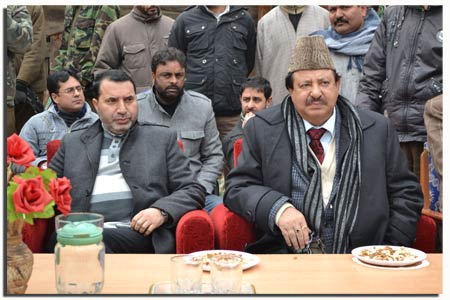Fear and anguish have pervaded the inhabitants of a south Kashmir village where nearly 30 per cent of the screened population has tested positive for the Hepatitis C virus. Experts fears that the epidemic might spread to adjoining villages if immediate steps are not taken to contain the virus, Suhail A Shah reports.

Oblivious of the lashing rain and a group of children playing merrily around him, Abdul Majeed, a 52-year-old labourer, sits at the far corner of a row of shops, which serves as the marketplace for inhabitants of Takia Magam village in Kokernag area of Islamabad district, some 70 kilometres south of Srinagar city.
Majeed is almost shaken out of his slumber the moment he hears the word ‘virus’ and runs for cover, as if somebody was trying to hit him in the back of his head, “You see he does not want to talk to anybody about this,” says one of the shopkeepers.
After returning from Shimla where he works as a labourer in January this year, Majeed had gone to a doctor complaining of piles. However, the doctor advised him to run some blood tests which diagnosed that he was carrying the Hepatitis-C virus.
Following the incident, a lady doctor from a neighbouring village advised around seven expecting mothers to get some blood tests done and they too tested positive for the virus, “That was the beginning of it all,” says a village elderly.
While the process of screening the inhabitants has just begun, nearly 450 people from Takia Magam village which has a population of over 4000 have tested positive for the Hepatitis C virus.
“Nearly 1600 samples have been taken from the village and so far 450 have been tested positive, including women and children as young as five years old,” says Shabir Ahmad, a local chemist.
The bad news, however, is that the experts fear more positive cases, not only in this village, but in the adjoining ones as well. “There is no doubt that this is taking an epidemic level and needs serious government attention at the earliest,” says Dr Sultan Muhammad Khuroo, an eminent gastroenterologist of the valley appointed by the state government to file a report on Hepatitis-C outbreak in this south Kashmir village.
While Dr Khuroo maintains that the infection is decades old and they have just stumbled upon it now, the locals in Takia Magam village reinforce his views and say that there have been around 15 deaths in the village pertaining to liver ailments over the last eight to ten years. “We thought it was jaundice or something. How could we know the real reason? Our village does not even have a doctor,” said Mushtaq Ahmad, a shopkeeper in the village.
The fact that the virus, in most of the cases, does not cause any problems for more than two decades, making it all the more dangerous and hard to detect unless proper tests are done.

According to World Health Organisation (WHO), Hepatitis-C virus is found in two percent of the world’s population with highest cases reported in Egypt, where nearly 15 percent of the population is affected, followed by Pakistan and China with 4.8 percent and 3.2 percent respectively. The main mode of transmission in these countries is attributed to unsafe injections using contaminated equipment.
“About 150 million people are chronically infected with Hepatitis C virus, and more than 350 000 people die every year from Hepatitis C-related liver diseases,” reads the media section of the WHO website.
However, Dr Khuroo feels that the outbreak in Takia Magam can be more menacing than all the others cases across the world with the virus in this particular village threatening to engulf more than 60 per cent of the total village population.
The medical science says the virus is essentially transmitted through infected needles, or to be more precise, any kind of blood contact including organ transplants, blood transfusions, tattooing, using pre-used blades at the barbers’, and unhygienic conditions at the dentists’.
Then there are the lesser affecting reasons like unprotected sexual contacts and being born to an infected mother. There are other factors which have to be kept into consideration in Takia Magam village. Most of the men go outside the state to work as labourers. Moreover, a sizeable number of men have married girls from Bihar and Bengal.
However, Dr Khuroo rules out these reasons as the cause of the epidemic, “Men go out for work and can sometimes have unprotected sex or get infected by any other source, but what about the kids that have got infected. They have not even ventured outside of their village,” Dr Khuroo argues.
He upholds that the reuse of needles is by far the biggest source of the transmission of this virus and in this particular outbreak, all the evidence is pointing towards that practice. According to reports, most of the samples that have tested positive show exactly the same virus, which essentially means that the source has been the same.
The Takia Magam village, despite being based on more than 500 households, has so far been kept devoid of a health centre by the government; the inhabitants more or less remain dependent on three local chemists, one of whom who has been practising for more than 40 years now, has been infected by the virus himself.
“There is no proof as of now that the chemist has been the source. However the virus in this village is decades old and he has been the only medical practitioner in the area during that period of time,” adds Dr Khuroo.
The disposable syringes have been in the market since the last 10 or 15 years. What kind of needles the village chemists used before will be the determining factor, according to the doctors.
The source of the infection might or might not be known subsequently, but what stares a large chunk of the people right in their faces is the treatment and the costs involved. “A single injection costs Rs 7500 and the number of injections varies from 24 to 48, depending on what genotype the virus belongs to. And then there are the tests to be conducted,” says a local, already undergoing treatment at a private hospital in Srinagar.
With the treatment cost stacked at a minimum of Rs 2 lakh, the affected people have all their hopes pinned on the government to announce some sort of a relief package. “Most of us don’t even have land so that we could sell that off and get treated. And even if somebody has the land, who is going to purchase it with more than half the population in dire need of money?” the locals ask.
The locals say that the representatives of the government have visited them and they have been promised free treatment but what remains to be seen is whether it would be just another public relations exercise or the government is really serious.
“From the last 50 years, the successive governments have been promising us a primary health centre but we never got one. We can just wait and watch this time around too,” the locals say.
The government on the other hand should not be only worried about providing the treatment to the affected people; there is another pressing issue at hand to prevent the secondary transmission of the virus to other parts of the valley. According to WHO, more than 3 to 4 million people get infected with the Hepatitis-C virus each year and a sizeable chunk of them get affected by the secondary transmission.
In Egypt alone, more than half a million people get secondary infection every year and the medical practitioners, of different fields are found guilty of being callous and carrying forward the infection. “Dentists, doctors, nurse and on a more localized level the barbers have been found the major carrying forward force of the infection,” says Dr Khuroo.
An Indian Cardiologist was jailed for life in the Nevada state of United States in 2008 for infecting thousands of people with the Hepatitis-C virus by using the same needles multiple times to save money. The experts argue that if such things can happen in the medically advanced nation like the United States, it is bound to happen in Kashmir through unawareness, if not by any other reason.
The need of the hour, Dr Khuroo says, is to create mass awareness among the people and more importantly among the doctors and other medical practitioners, “If the epidemic is not taken care of very seriously by the government, we might soon be heading the Egypt way,”
The authorities meanwhile maintain that the issue is being taken very seriously and due cognizance will be taken, “I have appointed the Director Health Services to take stock of the epidemic,” says the Divisional Commissioner of Kashmir, Dr Asghar Hasan Samoon.
Director Health Services, Kashmir, Dr Saleem-ur-Rehman told Kashmir Life said that his department is right now busy with the screening of the patients. “Meanwhile we have intimated the Government of India and authorities at SKIMS to help us carry forward the screening and the treatment procedures,” he said.
He, however, claimed that the decision regarding the modus operandi of the treatment will be taken by the state government in due time, “I cannot say whether the treatment will be free or not,” When asked about the concerns raised by Dr Khuroo about the threat of secondary infection, Dr Saleem-ur-Rehman said that he cannot comment on that. “You can ask Dr Khuroo about that. I don’t know about any such thing,” said the director.
The sad part is that there are no vaccines available for the prevention of this particular infection, even though billions of dollars are spent annually on conducting researches globally to develop one. However, the risk of getting infected can be considerably reduced by avoiding unnecessary and unsafe injections, unsafe blood products, unsafe sharps waste collection and disposal, use of illicit drugs and sharing of injection equipment, unprotected sex with hepatitis C-infected people, sharing of sharp personal items that may be contaminated with infected blood, tattoos, piercings and acupuncture performed with contaminated equipment.















